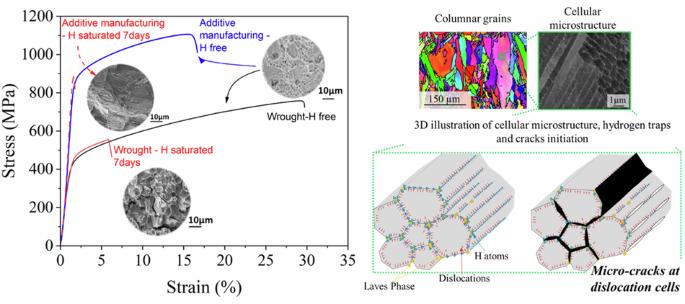Influence of dislocation cells on hydrogen embrittlement in wrought and additively manufactured Inconel 718
IF 9.6
Q1 MATERIALS SCIENCE, MULTIDISCIPLINARY
引用次数: 0
Abstract
Hydrogen embrittlement (HE) is a major issue for the mechanical integrity of high-strength alloys exposed to hydrogen-rich environments, with diffusion and trapping of hydrogen being critical phenomena. Here, the role of microstructure on hydrogen diffusion, trapping and embrittlement in additively manufactured (AM) and wrought Inconel 718 is compared, revealing the key role played by dislocation cells. Trapping behaviour in hydrogen-saturated alloys is analysed by thermal desorption spectroscopy and numerical simulations. A high density of hydrogen traps in cell walls, attributed to dense dislocations and Laves phases, are responsible for the local accumulation of hydrogen, causing significant loss in strength, and triggering cracking along dislocation cell walls. The influential role of dislocation cells alters fracture behaviour from intergranular in the wrought alloy to intragranular for the AM alloy, due to the large proportion of dislocation cells in AM alloys. In addition, the cellular network of dislocations accelerates hydrogen diffusion, enabling faster and deeper penetration of hydrogen in the AM alloy. These results indicate that the higher HE susceptibility of nickel superalloys is intrinsically associated with the interaction of hydrogen with dislocation walls. Hydrogen embrittlement is a major issue in alloys used in hydrogen-rich environments, such as in jet engines. In this study, the presence of a large number of dislocation cells in an additively manufactured nickel superalloy promotes hydrogen diffusion and fracture, as compared to a wrought alloy with fewer dislocation cells.

位错单元对锻造和加成型 Inconel 718 氢脆的影响
氢脆(HE)是暴露在富氢环境中的高强度合金机械完整性的一个主要问题,其中氢的扩散和捕获是关键现象。本文比较了微观结构对添加制造(AM)和锻造 Inconel 718 中氢扩散、捕集和脆化的作用,揭示了位错电池所起的关键作用。通过热解吸光谱和数值模拟分析了氢饱和合金中的捕获行为。由于致密位错和 Laves 相的存在,晶胞壁中的氢陷阱密度很高,导致氢在局部积聚,造成强度显著下降,并引发沿位错晶胞壁的裂纹。位错晶胞的影响作用改变了断裂行为,从锻造合金的晶间断裂转变为 AM 合金的晶内断裂,这是由于 AM 合金中位错晶胞所占比例较大。此外,位错蜂窝网络加速了氢扩散,使氢在 AM 合金中的渗透更快、更深。这些结果表明,镍超合金较高的氢脆敏感性与氢与位错壁的相互作用有内在联系。氢脆是在喷气发动机等富氢环境中使用的合金的一个主要问题。在这项研究中,与位错单元较少的锻造合金相比,在添加制造的镍超合金中存在大量位错单元会促进氢扩散和断裂。
本文章由计算机程序翻译,如有差异,请以英文原文为准。
求助全文
约1分钟内获得全文
求助全文
来源期刊

Communications Materials
MATERIALS SCIENCE, MULTIDISCIPLINARY-
CiteScore
12.10
自引率
1.30%
发文量
85
审稿时长
17 weeks
期刊介绍:
Communications Materials, a selective open access journal within Nature Portfolio, is dedicated to publishing top-tier research, reviews, and commentary across all facets of materials science. The journal showcases significant advancements in specialized research areas, encompassing both fundamental and applied studies. Serving as an open access option for materials sciences, Communications Materials applies less stringent criteria for impact and significance compared to Nature-branded journals, including Nature Communications.
 求助内容:
求助内容: 应助结果提醒方式:
应助结果提醒方式:


